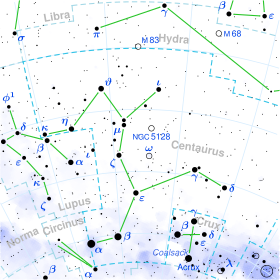Tau Centauri, Latinized from τ Centauri, is a solitary[11] star in the southern constellation of Centaurus. It is visible to the naked eye with an apparent visual magnitude of +3.86.[2] The distance to this star, based upon an annual parallax shift of 24.85 mas,[1] is 131 light years. There is a 98% chance that it is a co-moving companion of Gamma Centauri; the two stars have an estimated separation of 1.7 ly (0.53 pc).[12]
| Observation data Epoch J2000.0 Equinox J2000.0 (ICRS) | |
|---|---|
| Constellation | Centaurus |
| Right ascension | 12h 37m 42.16377s[1] |
| Declination | −48° 32′ 28.6899″[1] |
| Apparent magnitude (V) | +3.86[2] |
| Characteristics | |
| Spectral type | A0 V[3] or A1 IVnn[4] |
| U−B color index | +0.04[2] |
| B−V color index | +0.06[2] |
| Astrometry | |
| Radial velocity (Rv) | +5.5±2.3[5] km/s |
| Proper motion (μ) | RA: −186.26[1] mas/yr Dec.: −6.01[1] mas/yr |
| Parallax (π) | 24.85 ± 0.53 mas[1] |
| Distance | 131 ± 3 ly (40.2 ± 0.9 pc) |
| Absolute magnitude (MV) | +0.83[6] |
| Details | |
| Mass | 2.31[7] M☉ |
| Radius | 2.2[8] R☉ |
| Luminosity | 42[6] L☉ |
| Surface gravity (log g) | 4.02±0.14[7] cgs |
| Temperature | 10,533±358[7] K |
| Rotational velocity (v sin i) | 296.8±3.8[9] km/s |
| Age | 132[7] Myr |
| Other designations | |
| Database references | |
| SIMBAD | data |
This is an A-type star with stellar classifications of A0 V[3] or A1 IVnn,[4] indicating it may be a main sequence star or a more evolved subgiant star. It is around 132[7] million years old and is spinning rapidly with a projected rotational velocity of 296.8[9] km/s. This is giving the star an oblate shape, with an estimated equatorial girth that is 30% larger than the polar radius.[13] The star has an estimated 2.3[7] times the mass of the Sun and 2.2[8] times the Sun's radius.
References
edit- ^ a b c d e f van Leeuwen, F. (2007), "Validation of the new Hipparcos reduction", Astronomy and Astrophysics, 474 (2): 653–664, arXiv:0708.1752, Bibcode:2007A&A...474..653V, doi:10.1051/0004-6361:20078357, S2CID 18759600.
- ^ a b c d Mermilliod, J.-C. (1986), "Compilation of Eggen's UBV data, transformed to UBV (unpublished)", Catalogue of Eggen's UBV Data, SIMBAD Astronomical Database, Bibcode:1986EgUBV........0M.
- ^ a b Lagrange, A.-M.; et al. (February 2009), "Extrasolar planets and brown dwarfs around A-F type stars. VI. High precision RV survey of early type dwarfs with HARPS", Astronomy and Astrophysics, 495 (1): 335–352, arXiv:0809.4636, Bibcode:2009A&A...495..335L, doi:10.1051/0004-6361:200810105, S2CID 62894956.
- ^ a b Gray, R. O.; Garrison, R. F. (July 1989), "The late A-type stars - Refined MK classification, confrontation with Stromgren photometry, and the effects of rotation", Astrophysical Journal Supplement Series, 70 (4): 623–636, Bibcode:1989ApJS...70..623G, doi:10.1086/191349.
- ^ de Bruijne, J. H. J.; Eilers, A.-C. (October 2012), "Radial velocities for the HIPPARCOS-Gaia Hundred-Thousand-Proper-Motion project", Astronomy & Astrophysics, 546: 14, arXiv:1208.3048, Bibcode:2012A&A...546A..61D, doi:10.1051/0004-6361/201219219, S2CID 59451347, A61.
- ^ a b Anderson, E.; Francis, Ch. (2012), "XHIP: An extended hipparcos compilation", Astronomy Letters, 38 (5): 331, arXiv:1108.4971, Bibcode:2012AstL...38..331A, doi:10.1134/S1063773712050015, S2CID 119257644.
- ^ a b c d e f David, Trevor J.; Hillenbrand, Lynne A. (2015), "The Ages of Early-Type Stars: Strömgren Photometric Methods Calibrated, Validated, Tested, and Applied to Hosts and Prospective Hosts of Directly Imaged Exoplanets", The Astrophysical Journal, 804 (2): 146, arXiv:1501.03154, Bibcode:2015ApJ...804..146D, doi:10.1088/0004-637X/804/2/146, S2CID 33401607.
- ^ a b Pasinetti Fracassini, L. E.; et al. (February 2001), "Catalogue of Apparent Diameters and Absolute Radii of Stars (CADARS)", Astronomy and Astrophysics, 367 (3rd ed.): 521–524, arXiv:astro-ph/0012289, Bibcode:2001A&A...367..521P, doi:10.1051/0004-6361:20000451, S2CID 425754.
- ^ a b Díaz, C. G.; et al. (July 2011), "Accurate stellar rotational velocities using the Fourier transform of the cross correlation maximum", Astronomy & Astrophysics, 531: A143, arXiv:1012.4858, Bibcode:2011A&A...531A.143D, doi:10.1051/0004-6361/201016386, S2CID 119286673.
- ^ "* tau Cen". SIMBAD. Centre de données astronomiques de Strasbourg. Retrieved 2017-01-13.
{{cite web}}: CS1 maint: postscript (link) - ^ De Rosa, R. J.; et al. (January 2014), "The VAST Survey - III. The multiplicity of A-type stars within 75 pc", Monthly Notices of the Royal Astronomical Society, 437 (2): 1216–1240, arXiv:1311.7141, Bibcode:2014MNRAS.437.1216D, doi:10.1093/mnras/stt1932, S2CID 88503488.
- ^ Shaya, Ed J.; Olling, Rob P. (January 2011), "Very Wide Binaries and Other Comoving Stellar Companions: A Bayesian Analysis of the Hipparcos Catalogue", The Astrophysical Journal Supplement, 192 (1): 2, arXiv:1007.0425, Bibcode:2011ApJS..192....2S, doi:10.1088/0067-0049/192/1/2, S2CID 119226823
- ^ Belle, G. T. (2012), "Interferometric observations of rapidly rotating stars", The Astronomy and Astrophysics Review, 20 (1): 51, arXiv:1204.2572, Bibcode:2012A&ARv..20...51V, doi:10.1007/s00159-012-0051-2, S2CID 119273474.
